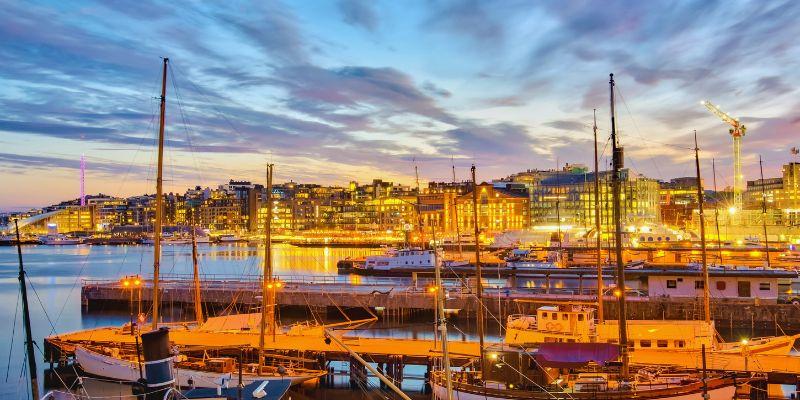Europe has all-weather appeal with his number of climates and attractions. The spring month blooms and the warm winter markets have been different and are all part of the seasons. You can always save money by traveling seasonally, planning a visit to some sunny beaches, cultural festivals or even snowy escapes so that your trip will be full of unforgettable moments depending on what you like.
Spring in Europe: Blossoms, Renewal, and Comfortable Exploration

One of the most pleasant time to explore Europe is during spring or the months of March to May. With the retreat of winter the cities and country take on life. The temperatures are easy and the outdoors are vibrant and one gets the feeling of rejuvenation.
Gardens and parks are the most ideal places to see the beauty of spring. The Luxembourg Gardens of Paris, the Schoenbrunn Palace grounds of Vienna and Amsterdam, Keukenhof Gardens are covered with blossom of varied colours and sizes. The Netherlands turns into an oasis of color, brain of interminable fields of tulips, which impresses postcards and brings people in the world.
Culture lovers who travel will experience good things during spring. Local experiences in Europe where Easter traditions give rise to processions in Spain, decorated markets in Central Europe and so on. In the meantime, places such as Rome and Florence are manageable to see than in summer, when there aren’t people scurrying all over the historical buildings.
Summer in Europe: Vibrancy, Long Days, and Endless Adventure
Summer, between June and August is the time the Europe energy is at its finest. Making the cities, towns and coasts lively hot weather and long days and a merry mood all turn them into very active centers.
Southern Europe is popular especially during the summer. Spain, Italy, Portugal and Greece provide sun filled beaches, Mediterranean lunches and test opportunity to blend leisure with an adventure trip into the culture. Cruising to Greek islands, explore coastal Italy in the flow of Italian towns or strolling over the streets in Barcelona under the sunshine are places tourists fantasize about during their travels.
Further north the summer is also pleasant. The stunning landscapes, fjords, forests found in countries such as Norway, Sweden and Finland are truly breathtaking with almost endless daylight periods. The phenomenon of midnight sun in the North Scandinavian countries is unforgettable as it enables visitors to hike or go on boats long after this time should be considered the nighttime. Such cities of Central Europe as Prague, Vienna and Budapest have outdoor concerts, cultural festivals, and bustling street life, which are in their best at this period.
However summers are problems too. It is the peak of high-season, thus iconic places like Eiffel tower or Venice canals are going to be crowded. The cost of flights and hotels increases greatly and they have to book months beforehand. Due to the popularity of the season the wait times may also rise in the attractions.
Nevertheless, there is no air like that of Europe in summer. It is walking with the locals in an outdoor fest, mountain-landscape hiking between Switzerland, sailing the Croatia vivid shore of the Adriatic sea summer, offers invaluable experiences to travelers who have energy and can enjoy the sun.
Autumn in Europe: Golden Scenery, Cultural Richness, and Pleasant Travel
Autumn, between September and November is a transition period that provides the traveler with a more rewarding yet quieter experience. The summer heatpack gives way to the cool crispy atmosphere, the plow landscape becomes gold, red, and orange colors.
Autumn is mainly beautiful in Central and Eastern Europe. Austria, Germany and Slovenia forests are turned into works of art, ideal during hiking and scenic drives. In France, Italy, and Spain vineyards also enter their peak seasons and help to draw the breathtaking city scenes. It is much more relaxing in cities such as Prague, Budapest, and Krakow than during the tourist-packaged summer, although there is still cultural life full of festivals, art exhibitions and concerts.
Autumn is the perfect season to most travelers. It is also comfortable without the presence of the summer heat so visitors can sightsee outdoors. Meanwhile, airfare and hotel cost start to go down, which makes it a cost-efficient option. Crowds become significantly smaller, which means that the visitors would be able to discover Medieval structures like the Duomo in Florence or the old streets in Berlin with a lot more comfort.
When the season is early autumn, it is also the ideal time to explore the coastline in southern Europe. Greece, Portugal and southern Italy have warm weather even in September so the effect is to be able to have a taste of beaches without the summer congestion.
Winter in Europe: Snow, Festivities, and Enchanting Atmospheres

Practically the sole season not illustrated in your descriptions, winter, which, with the months of December and generally of February, is approaching, shows a totally different aspect of Europe. Alpine areas are covered with snow, traditional cities are filled with Christmas decorations, and homely traditions have come to the fore.
Winter sports lovers have no choice but to be in the Alps. Switzerland, Austria, France and Italy also have temples of ski resorts with spectacular mountainous sceneries. In addition to skiing, winter scenery promotes such activities as snowshoeing, ice skating or simple observation of the beauty of snow-covered villages.
The winter season encompasses a magical warmness in cities. Germany, Austria, and Czech Republic countries are well known on holiday markets that illuminate town squares with ornaments, music performances and crafts of the season. Some of the most fascinating places during this period are Vienna, Strasbourg and Dresden. The friendly feel of the place makes the coldest nights warm.
The southern part of Europe is cosy to those who enjoy milder weather. Portugal, southern Spain and Greece have nice temperatures thus they are better places to visit without the crowds that are attracted during summer.
There are also financial merits of winter travelling. During off seasons other than those as during the holiday weeks during December, flights and hotels are much cheaper. There are indoor activities that can be performed in museums, theaters and other cultural institutions in Europe that ensures that tourists do not have to avoid the continent in case the outdoor temperatures drop.
Conclusion
Europe is a continent of seasons, each with its own personality and charm. Planning your trip around the right time of year can make the difference between a good journey and an extraordinary one. Whether you find joy in spring blossoms, summer adventures, autumn colors, or winter festivities, the continent always has something unique to offer. What truly makes Europe special is its ability to transform with the seasons while retaining its timeless allure.












